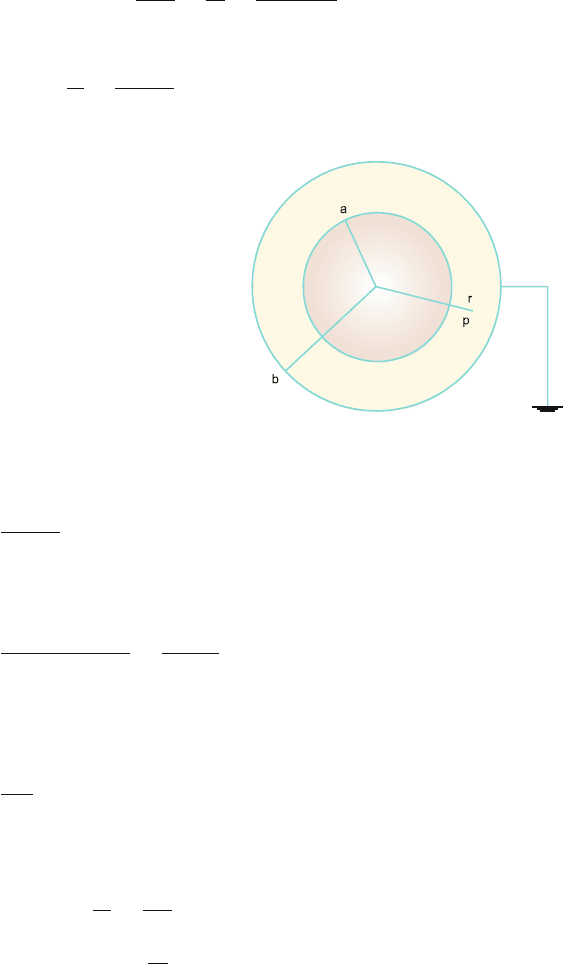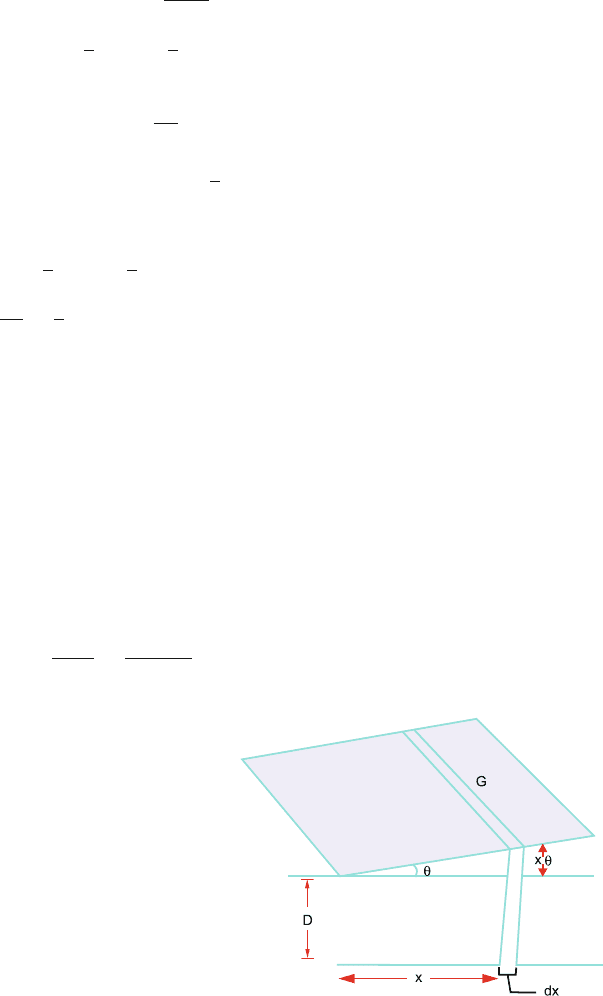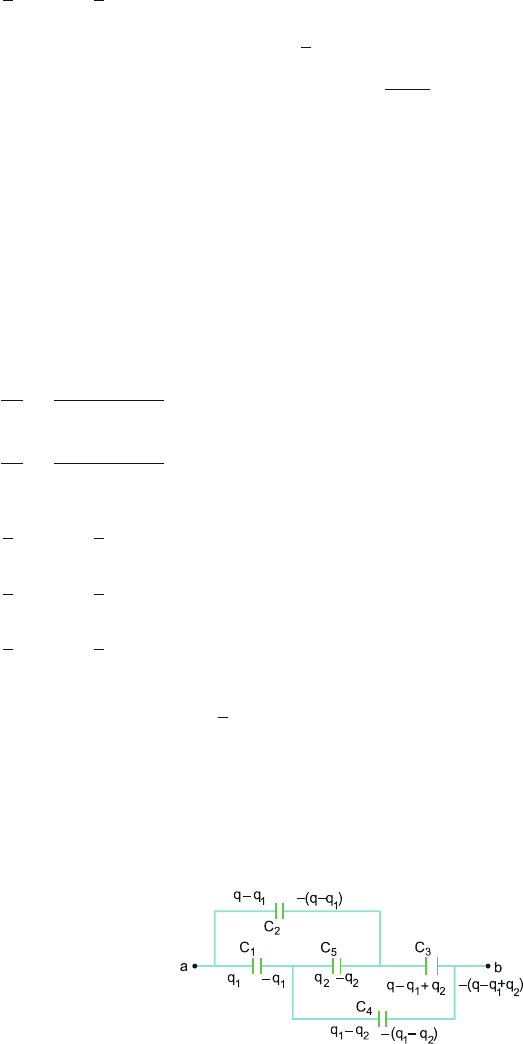Kamal A.A. 1000 Solved Problems in Classical Physics: An Exercise Book
Подождите немного. Документ загружается.


11.3 Solutions 519
11.73 Q = C
1
V = 5 ×10
−6
× 250 = 1.25 × 10
−3
C
For the parallel connection
C = C
1
+ C
2
= 5 ×10
−6
+ 20 × 10
−6
= 25 ×10
−6
F
The resulting voltage
V
=
Q
C
=
1.25 × 10
−3
25 × 10
−6
= 50 V
11.74 The combination of 2 μF and 2 μF in parallel is equivalent to 4 μF. This in
series with 8 μF gives a combined capacitance of 8/3 μF; 12 μF and 6 μF
in series gives an equivalent capacitance of 4 μF. 4 μF with 4 μF in parallel
gives 8 μF which in series with 1 μF yields 8/9 μF.
Combination of 8/9 μF and 8/3 μF in parallel gives 32/9 μF.
Effective value of C with 32/9 μF in series gives
32
9
C
C +
32
9
= 1, by problem
∴ C = 1
9
23
μF
11.75 Combined capacitance C for the three capacitors in series:
C =
C
1
C
2
C
3
C
1
C
2
+ C
2
C
3
+ C
3
C
1
=
(4 × 3 × 2) × 10
−18
(4 × 3 + 3 × 2 +2 × 4) × 10
−12
= 0.923 ×10
−6
F
(a)
q = CV = 0.923 × 10
−6
× 260 = 240 × 10
−6
C
∴ q
1
= q
2
= q
3
= 240 ×10
−6
C
(b)
V
1
=
q
C
1
=
240 × 10
−6
4 × 10
−6
= 60 V
V
2
=
q
C
2
=
240 × 10
−6
3 × 10
−6
= 80 V
V
3
=
q
C
3
=
240
2
= 120 V
(c)
W
1
=
1
2
C
1
V
2
1
=
1
2
× 4 × 10
−6
× (60)
2
= 0.0072 J
W
2
=
1
2
C
2
V
2
2
=
1
2
× 3 × 10
−6
× (80)
2
= 0.0096 J
W
3
=
1
2
C
3
V
2
3
=
1
2
× 2 × 10
−6
× (120)
2
= 0.0144 J

520 11 Electrostatics
11.76 Charge on the first capacitor
q
1
= C
1
V = 1 ×10
−6
× 12 = 12 × 10
−6
C
Charge on the second capacitor
q
2
= C
2
V = 2 ×10
−6
× 12 = 24 × 10
−6
C
Capacitance for the parallel combination
(a)
C = C
1
+ C
2
= (1 +2) ×10
−6
= 3 ×10
−6
F
q = q
1
+q
2
= (12 +24) × 10
−6
= 36 ×10
−6
C
V =
q
C
=
36 × 10
−6
3 × 10
−6
= 12 V
(b)
q
= q
2
−q
1
= (24 −12) × 10
−6
= 12 ×10
−6
C
V =
q
C
=
12 × 10
−6
3 × 10
−6
= 4V
11.77 (a) If the positive end of a capacitor of capacitance C
1
, charged to potential
difference V
1
, is connected in parallel to the positive end of the capacitor
of capacitance C
2
charged to potential difference V
2
, then conservation
of charge gives the equation
(C
1
+ C
2
)V = C
1
V
1
+ C
2
V
2
(1)
∴ V =
C
1
V
1
+ C
2
V
2
C
1
+ C
2
(common potential) (2)
The energy loss
W =
1
2
C
1
V
2
1
+
1
2
C
2
V
2
2
−
1
2
(C
1
+ C
2
) V
2
=
1
2
C
1
C
2
C
1
+C
2
(V
1
− V
2
)
2
(3)
where we have used (2).
(b) If the positive end is joined to the negative end, the common potential
difference will be
V =
C
1
V
1
− C
2
V
2
C
1
+ C
2
(4)
and the energy loss will be
W =
1
2
C
1
C
2
C
1
+C
2
(V
1
+ V
2
)
2
(5)

11.3 Solutions 521
11.78
(a) Battery remains connected
(i) V
= V ; potential remains unchanged.
(ii) E
= E; electric field is unchanged.
(iii) q
= Kq; charge is increased by a factor K . The additional charge
(K − 1)q is moved from the negative to the positive plate by the
battery, as the dielectric slab is inserted.
(iv) C
= KC; capacitance is increased by a factor K .
(v) U
=
1
2
q
V
=
1
2
KqV = KU
Energy is increased by a factor K .
(b) The battery is disconnected
(i) V
=
V
K
; potential is decreased by a factor K
(ii) E
=
E
K
; electric field is decreased by a factor K . Both (i) and (ii)
follow from the fact that q
= q so that C
V
= CV and V
=
CV
C
=
V
K
. Same reasoning holds good for E
.
(iii) q
= q; charge remains unchanged as there is no path for charge
transfer.
(iv) C
= KC; capacitance is increased by a factor K .
(v) U
=
1
2
q
V
=
1
2
qV
K
=
U
K
The energy is lowered by a factor K .
11.79
(a) The battery remains connected
(i) V
= V ; potential remains unchanged.
(ii) E
< E; the electric field is decreased since E = V/d, and V is
constant.
(iii) C
< C; capacitance is reduced since C ∝ 1/d.
(iv) q
< q; the charge is reduced since q = CV, with C decreas-
ing and V remaining constant. Some charge is transferred from the
capacitor to the charging battery.
(v) U
< U; the energy is decreased since U =
1
2
qV, with q decreas-
ing and V remaining constant.
(b) Battery is disconnected
(i) V
> V , the potential increases because q = CV, with C decreas-
ing and q remaining constant.
(ii) E
= E, the electric field is constant because q = CV =
ε
0
AV
d
=
ε
0
AE, with q remaining constant.
(iii) C
< C; the capacitance is decreased since C ∝ 1/d.

522 11 Electrostatics
(iv) q
= q; the charge remains constant.
(v) U
> U; energy increases because U =
1
2
qV, with V increasing
and q remaining constant.
11.80 As the plates carry equal but opposite charges, the force of attraction, which
is conservative, is given by
F =−
dU
dx
But U =
1
2
q
2
C
For the parallel plate capacitor,
C =
ε
0
A
x
where x is the distance of separation. Combining the above equations
F =−
d
dx
1
2
q
2
x
ε
0
A
=−
q
2
2ε
0
A
=−
1
2
ε
0
AV
2
d
2
where we have put x = d.
11.81
(a) As the drops are assumed to be incompressible, the volume does not
change.
4
3
π R
3
= n
4
3
πr
3
∴ R = n
1/3
r
(b)
C
= 4πε
0
R = 4πε
0
rn
1/3
∴ C
= n
1/3
C
(c) Q = nq (charge conservation)
V
=
Q
4πε
0
R
=
nq
4πε
0
n
1/3
r
=
n
2/3
q
4πε
0
r
= n
2/3
V
(d) σ
=
Q
4π R
2
=
nq
4π r
2
n
2/3
= n
1/3
σ
(e) U
=
1
2
QV
=
1
2
nqn
2/3
V = n
5/3
U

11.3 Solutions 523
11.82 The electric field for a cylindrical capacitor is
E =
q
2πε
0
lr
(1)
where l is the length and r the radius. The energy density (energy/unit vol-
ume)
u =
1
2
ε
0
E
2
=
q
2
8π
2
ε
0
l
2
r
2
(2)
wherewehaveused(1).
The energy stored between the coaxial cylinders of length l and radii R and
a is
U =
udv =
R
a
u (2πrl) dr (3)
where dv = (2πrdr)l is the volume element. Using (2) in (3)
U =
q
2
4πε
0
l
R
a
dr
r
=
q
2
4πε
0
l
ln
R
a
Similarly, the energy stored between the coaxial cylinders of radii b and a is
U
0
=
q
2
4πε
0
l
ln
b
a
∴
U
U
0
=
ln (R/a)
ln (b/a)
Set
U
U
0
=
1
2
∴
ln (R/a)
ln (b/a)
=
1
2
→ ln
b
a
= 2ln
R
a
= ln
R
2
a
2
or
b
a
=
R
2
a
2
→ R =
√
ab
11.83 The charge on C
1
is
q
1
= C
1
V
1
= 3 ×10
−6
× 4000 = 0.012 C

524 11 Electrostatics
The charge on C
2
is
q
2
= C
2
V
2
= 6 ×10
−6
× 3000 = 0.018 C
The combined capacitance
C =
C
1
C
2
C
1
+ C
2
=
3 × 6
3 + 6
× 10
−6
= 2 ×10
−6
F
Take the lower charge to find the maximum voltage V :
V =
q
1
C
=
0.012
2 × 10
−6
= 6000 V
11.84 If the dielectric is present, Gauss’ law gives
ε
0
E · ds = q − q
=
q
K
(1)
where −q
is the induced surface charge, q is the free charge and K is the
dielectric constant. Construct a Gaussian surface in the form of a coaxial
cylinder of radius r and length l, closed by end caps. Applying (1),
ε
0
E (2πrl) =
q
K
or E =
q
2πε
0
rlk
(2)
In (1) the integral is contributed only by the curved surface and not the end
caps. The potential difference between the central rod and the surrounding
tube is given by
V =−
b
a
E · dr =
b
a
E dr =
b
a
q
2πε
0
lK
dr
r
=
q
2πε
0
lK
ln
b
a
The capacitance is given by
C =
q
V
=
2πε
0
lK
ln (b/a)
11.85 The field at point P is caused entirely by the charge Q on the inner sphere,
Fig. 11.45, and has the value
E =
Q
4πε
0
r
2

11.3 Solutions 525
The potential difference between the two spheres is given by
V =−
a
b
E · dr =−
Q
4πε
0
a
b
dr
r
2
=
Q (b −a)
4πε
0
ab
whence C =
Q
V
=
4πε
0
ab
b − a
Fig. 11.45
11.86 By prob. (11.85)
C =
4πε
0
ab
b − a
(1)
Let b = a + where is a small quantity. Then (1) can be written as
C =
4πε
0
a(a + a)
a
4πε
0
a
2
a
(2)
Now the surface area A = 4π a
2
and a = d, the distance between the
surfaces, so that
C
ε
0
A
d
(parallel plate capacitor)
11.87
(i) q = q
0
e
−t/RC
e
−t/RC
=
q
q
0
=
90
100
∴ t = RC ln
10
9
= 1 ×10
6
× 10 × 10
−6
× 0.1056 = 1.056 s

526 11 Electrostatics
(ii) At one time constant t = RC
V = V
0
e
−1
=
120
2.718
= 44.15 V
U =
1
2
CV
2
=
1
2
× 10 × 10
−6
× (44.15)
2
= 0.097 J
(iii) H = i
2
Rt =
V
2
R
t = V
2
C = (44.15)
2
× 10 × 10
−6
= 0.0195 J
11.88 Equilibrium energy U
0
=
1
2
CV
2
0
Energy at time t
U =
1
2
CV
2
=
1
2
CV
2
0
1 − e
−t/RC
2
= U
0
1 − e
−t/RC
2
U
U
0
=
1
2
=
1 − e
−t/RC
2
Solving t = 1.228RC .
Thus after 1.228 time constants the energy stored in the capacitor will reach
half of its equilibrium value.
11.89 Let the capacitor be divided into differential strips which are practically par-
allel. Consider a strip at distance x of length a perpendicular to the plane
of paper and of width dx in the plane of paper, t he area of the strip being
dA = adx,Fig.11.46. At the distance x, the separation of the plates is seen
to be t = D + xθ. The capacitance due to the differential strip facing each
plate is
dC =
ε
0
dA
D
=
ε
0
adx
D + x θ
Fig. 11.46

11.3 Solutions 527
The capacitance is given by
C =
dC =
a
0
ε
0
a dx
D + x θ
= ε
0
a
a
0
dx
D + x θ
=
ε
0
a
D
a
0
1 +
x θ
D
−1
dx
=
ε
0
a
D
a
0
1 −
xθ
D
+···
dx
ε
0
a
D
x −
x
2
θ
2D
a
0
=
ε
0
a
2
D
1 −
aθ
2D
Note that for θ = 0, capacitance reduces to that for the parallel plate capaci-
tor.
11.90
(a) The equivalent capacitance of C
1
and C
2
in parallel is C
12
= 8 + 4 =
12 μF.
The combined capacitance of C
12
and C
3
in series is C =
C
3
C
12
C
3
+ C
12
=
3 × 12
3 + 12
= 2.4 μF.
Applied charge q = CV = 2.4 × 100 = 240 μC. Therefore charge on
C
3
will be q
3
= 240 μC. PD across C
3
will be V
3
=
q
3
C
3
=
240
3
= 80 V.
The PD across C
1
and C
2
will be equal.
V
1
= V
2
= (V − V
3
) = (100 − 80) = 20 V
(b) Now
q
1
C
1
=
q
2
C
2
(∵ V
1
= V
2
)
∴ q
1
=
C
1
q
2
C
2
=
8
4
q
2
= 2q
2
Also q
1
+q
2
= 240
∴ q
1
= 160 μC and q
2
= 80 μC
(c)
U
1
=
1
2
C
1
V
2
1
=
1
2
× 8 × 10
−6
× 20
2
= 0.0016 J
U
2
=
1
2
C
2
V
2
2
=
1
2
× 4 × 10
−6
× 20
2
= 0.0008 J

528 11 Electrostatics
U
3
=
1
2
C
3
V
2
3
=
1
2
× 3 × 10
−6
× 80
2
= 0.0096 J
Note that U
1
+U
2
+U
3
= 0.012 J = U =
1
2
CV
2
11.91
(a) The combination of C
1
and C
2
in series yields C
12
=
8 × 4
8 + 4
= 2.667 ×
10
−6
F.
C = C
12
+C
3
= (2.667 +3.0) × 10
−6
= 5.667 ×10
−6
F
q = CV = 5.667 × 10
−6
× 100 = 5.667 × 10
−4
C
q
3
= C
3
V = 3 ×10
−6
× 100 = 3 × 10
−4
C
q
1
= q
2
= q − q
3
= (5.667 −3.0) ×10
−4
= 2.667 ×10
−4
C
(b) V
3
= 100 V
V
1
=
q
1
C
1
=
2.667 × 10
−4
8 × 10
−6
= 33.33 V
V
2
=
q
2
C
2
=
2.667 × 10
−4
4 × 10
−6
= 66.66 V
(c)
U
1
=
1
2
C
1
V
2
1
=
1
2
× 8 × 10
−6
× (33.33)
2
= 0.00444 J
U
2
=
1
2
C
2
V
2
2
=
1
2
× 4 × 10
−6
× (66.66)
2
= 0.00889 J
U
3
=
1
2
C
3
V
2
3
=
1
2
× 3 × 10
−6
× 100
2
= 0.015 J
Note that U
1
+U
2
+U
3
= U =
1
2
CV
2
, as it should.
11.92 Let the effective capacitance between points a and b be C. Apply a potential
difference V between a and b and let C be charged to q,Fig.11.47.
Let the charge across C
1
and C
5
be q
1
and q
5
, respectively; the charges across
various capacitors are shown in Fig. 11.47.
Fig. 11.47
